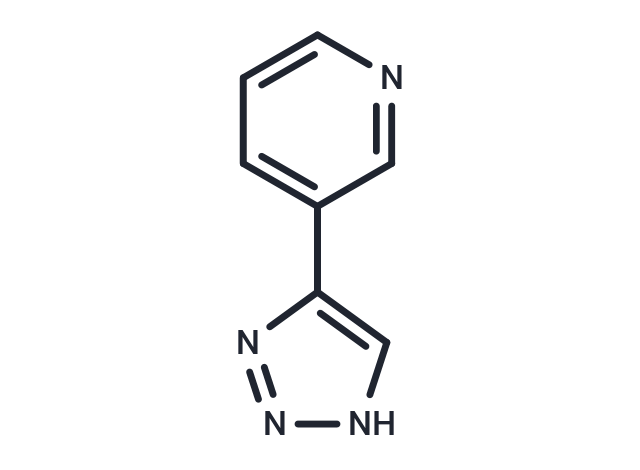Shopping Cart
Remove All Your shopping cart is currently empty
Your shopping cart is currently empty
3-TYP (3-(1H-1,2,3-triazol-4-yl) pyridine) is a selective SIRT3 inhibitor.

| Pack Size | Price | USA Warehouse | Global Warehouse | Quantity |
|---|---|---|---|---|
| 2 mg | $33 | In Stock | In Stock | |
| 5 mg | $48 | In Stock | In Stock | |
| 10 mg | $85 | In Stock | In Stock | |
| 25 mg | $169 | In Stock | In Stock | |
| 50 mg | $261 | In Stock | In Stock | |
| 100 mg | $413 | In Stock | In Stock | |
| 200 mg | $589 | In Stock | In Stock | |
| 1 mL x 10 mM (in DMSO) | $48 | In Stock | In Stock |
| Description | 3-TYP (3-(1H-1,2,3-triazol-4-yl) pyridine) is a selective SIRT3 inhibitor. |
| Targets&IC50 | SIRT2:92 nM, SIRT3:16 nM, SIRT1:88 nM |
| In vitro | 3-TYP significantly attenuates melatonin-induced increases in deacetylated-SOD2 expression and SOD2 activity in HepG2 cells exposed to Cd. 3-TYP inhibits melatonin-enhanced SIRT3 activity while not affecting SIRT3 protein expression. 3-TYP pretreatment reverses the protective effects of melatonin on cadmium (Cd)-induced mitochondrial-derived O2•− production and autophagic cell death. |
| In vivo | 3-TYP significantly reduces SIRT3 activity and increases SOD2 acetylation compared to the control group while not affecting SIRT3 expression. It undermines the cardioprotective effects of melatonin by reducing left ventricular ejection fraction (LVEF) and left ventricular fractional shortening (LVFS) and increases infarct size, serum lactate dehydrogenase (LDH) levels, and the apoptotic ratio after 24 hours of reperfusion, relative to the IR+Mel group. However, at a dose of 50 mg/kg, intraperitoneally (i.p.), 3-TYP shows no significant effect on LVEF, LVFS, infarct size, serum LDH levels, apoptosis, and oxidative stress compared to the Sham group. Additionally, 3-TYP does not significantly affect the expression levels of gp91phox, Nrf2, NQO 1, Bax, Bcl-2, Caspase-3, and cleaved Caspase-3 compared to the Sham group. |
| Cell Research | Cell viability is analyzed using Cell Counting Kit-8. 1×104 cells are inoculated into 96-well plates. After being treated, 90 μL of medium and 10 μL of CCK-8 solution are added to each well. The cells are then incubated at 37°C for 2 h. After incubation, the absorption at 450 nm is measured using an Infinite? M200 Microplate Reader. The results are expressed as a percentage of the control. The cell death is also evaluated using the trypan blue assay. HepG2 cells are plated in the 6-well plates (5×105 cells per well) and incubated for 24 h. After being treated with Cd or melatonin, the cells are detached with 300 μL trypsin-EDTA solution. The mixture of detached cells is centrifugated at 300 g for 5 min. Then, the residue is combined with 800 μL trypan blue solution and dispersed. After 3 min staining, cells are counted using an automated cell counter. The dead cells are stained with the blue color. Cell mortality (%) is expressed as percentage of the dead cell number/the total cell number. |
| Animal Research | 3-TYP is formulated in 1% ethanol.Male C57BL/6 mice are anesthetized with 2% isoflurane, and myocardial ischemia is produced by temporarily exteriorizing the heart via a left thoracic incision and placing a 6-0 silk suture slipknot around the left anterior descending coronary artery. After 30 minutes of myocardial ischemia, the slipknot is released, and the myocardium is reperfused for 3 hour (for western blot analysis and oxidative stress measurement) or 24 hour (for cardiac function, apoptotic index and infarct size determination). Sham-operated mice undergo the same surgical procedures except the suture placed under the left coronary artery is not tied. Ten minutes before reperfusion, mice are randomized to receive either vehicle (1% ethanol) or melatonin (20 mg/kg) by intraperitoneal injection. C57BL/6 mice are randomly divided into the following groups: (i) Sham group: mice underwent the sham operation and are treated with vehicle (1% ethanol); (ii) Mel group: mice are treated with melatonin (20 mg/kg via intraperitoneal injection); (iii) IR+V group: mice underwent the MI/R operation and are treated with vehicle (1% ethanol); (iv) IR+Mel group: mice underwent the MI/R operation and are treated with melatonin (20 mg/kg via intraperitoneal injection 10 minutes before reperfusion); (v) IR+Mel+3-TYP group: mice are pretreated with 3-TYP (3-TYP is intraperitoneally injected at a dose of 50 mg/kg every 2 days for a total of three doses prior to the MI/R surgery), subjected to the MI/R operation, and treated with melatonin (20 mg/kg via intraperitoneal injection 10 minutes before reperfusion); and (vi) IR+3-TYP group: mice are pretreated with 3-TYP and then subjected to the MI/R operation. |
| Synonyms | 3-(1H-1,2,3-triazol-4-yl) pyridine |
| Molecular Weight | 146.15 |
| Formula | C7H6N4 |
| Cas No. | 120241-79-4 |
| Smiles | c1[nH]nnc1-c1cccnc1 |
| Relative Density. | 1.296 g/cm3 (Predicted) |
| Storage | Powder: -20°C for 3 years | In solvent: -80°C for 1 year | Shipping with blue ice/Shipping at ambient temperature. | ||||||||||||||||||||||||||||||||||||||||
| Solubility Information | H2O: 5 mg/mL (34.21 mM), Sonication is recommended. Ethanol: 28 mg/mL (191.58 mM), Sonication is recommended. DMSO: 231 mg/mL (1580.57 mM), Sonication is recommended. | ||||||||||||||||||||||||||||||||||||||||
| In Vivo Formulation | 10% DMSO+40% PEG300+5% Tween 80+45% Saline: 5 mg/mL (34.21 mM), Sonication is recommended. Please add the solvents sequentially, clarifying the solution as much as possible before adding the next one. Dissolve by heating and/or sonication if necessary. Working solution is recommended to be prepared and used immediately. The formulation provided above is for reference purposes only. In vivo formulations may vary and should be modified based on specific experimental conditions. | ||||||||||||||||||||||||||||||||||||||||
Solution Preparation Table | |||||||||||||||||||||||||||||||||||||||||
H2O/Ethanol/DMSO
Ethanol/DMSO
| |||||||||||||||||||||||||||||||||||||||||
| Size | Quantity | Unit Price | Amount | Operation |
|---|

Copyright © 2015-2026 TargetMol Chemicals Inc. All Rights Reserved.